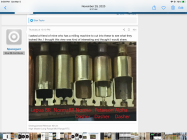i find it amazing in this day and age with all the tools we have available, some people still think it is ok to change a component of a load, the case this time, and just use their old load data WITH OUT WORKING UP A LOAD.
change part of a known load, work up a new load
I started handloading a long, long time ago for historic service rifles. None of us had access to a chronograph and for many years it was a case of using whatever Boxer-prime brass you could lay your hands on. (Being in Europe, nearly all ex-armoury cases were Berdan for my first decade or so of loading my own.)
With so few aids to help us, we loaded MILD - especially as rifles were mostly a half century or more old and the cartridges had MAPs below 50,000 psi, or maybe a little bit above. As a result, we got away with a lot. For instance, I would neck-size cases multiple times, initially using Lee Loader kits, later the Lee Collet, and only every full-length sized brass when switching it from one rifle to another. Components were routinely swapped according to availability, but apart from a few incompetents and/or chronic risk takers pressure-related problems were few and far between.
Today, things are very different. Look at half or more of the loads quoted on this and other forums, run them through QuickLOAD and/or compare with one's own loads and many are HOT, not just 'warm' but really pushing limits. Most of these people know what they're doing, but by no means all, and data are sometimes published without giving full details on rifle chambers and cartridge components. Complete tyros read some of these these posts and there is a risk they think they're normal, then go out a try them with minimal work-up but different makes of case, primer and whatever. I load a lot of bolt-action 223 Rem and have used components over the years with huge case weight and capacity variations and chambers that range from whatever Remington Arms' interpretation of a standard SAAMI 223 Rem 12-twist barrel chamber should be 20 odd years ago to a 90gn VLD custom job with 200 thou' plus freebore via Wylde, PT&G 223 Rem ISSF and a few others in between. Usable top loads have varied more than a little shall we say! BUT, today we have the benefits of far more manufacturers' loads data constantly updated online, internal ballistics prediction tools such as QuickLOAD and GRT and most of all some very good chronographs. (Actually all the free online data may be a bit of a trap. I worry about how many handloaders have never done any research on proper techniques, pressure signs, etc etc - in other words have never owned a single good manual and read it carefully.)
We're talking 6BR here in this thread. When I had my 600 yard 'Light Gun' rebarreled three years ago, I ran it in with the 107gn SMK and worked up to 30gn Viht N150. (Lapua case + CBC Magtech 7 1/2 primer). 100 yard five-shot groups were excellent as was ES/SD, but MVs were low at 2,695 fps (30-inch Benchmark). A friend and top GB BR competitor, way out of my league, had the sibling of this barrel on a 6BR Heavy Gun a year or two previously and initial work-up MVs were also low, so he worked up and up (N150 with a 105 of one sort or other) until he was getting Dasher MVs and really, really small groups at both 600 and 1,000 yards. This rifle, his handloads, and his young daughter were the combination to beat in UK BR Assoc. competition for a season, maybe season and a half. Then the barrel changed in some way after a not huge number of rounds and that load blew primers, load reduced - still blew primers, and this process went on for a while until he came down to 30 or 30.5gn. Sadly, it never recovered its initial precision either. My barrel came into the UK made at the same time in the same batch of Benchmark sixes. I'm still waiting for the pressure / MV rise, but getting on for 300 rounds down it, the MV has risen to exactly 2,700 fps. ............... and I'll just stick there thank you, even though I know most people on this forum will regard this as a pathetic MV from a 30-inch barrel 6BR bench gun. It's not that I shoot on a protected range either, quite the reverse and our 600 yard BR season is October to February with crosswind gusts regularly exceeding 20 mph. Many years ago when I was into modifying cars and engine 'tuning' one of the UK's most successful sports car racing outfits and suppliers of go-faster goodies for Triumphs had an excellent printed catalogue that had the words in bold type along the bottom of each page. "Speed Costs Money!" The risk with handloading isn't just extra monetary costs to be on the maximum that many apparently aspire to, but if we read the signs wrong, or don't know basic risks such as changing components without a new work-up, that the ultimate cost may be far greater than reduced barrel life, or retiring from a match for blown primers, or hard bolt lift.













